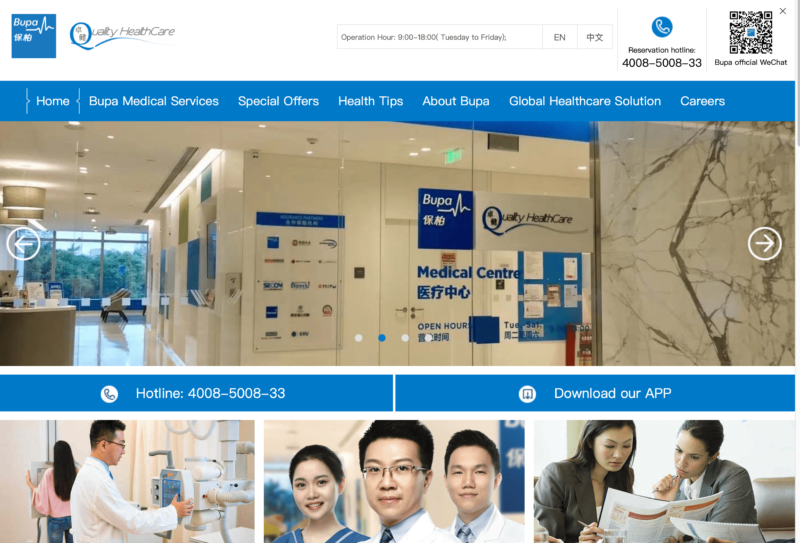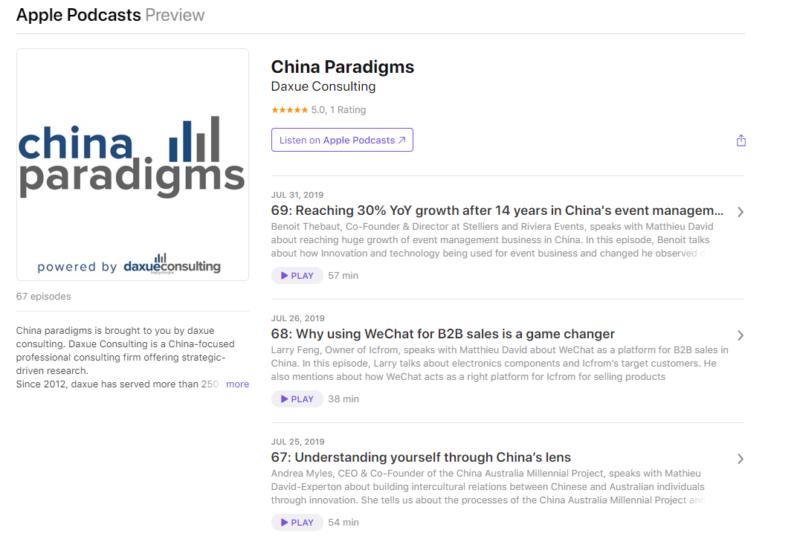Overview of the medical insurance market in China
The healthcare market in China is diversifying and growing rapidly. Medical expenditures reached 357 billion US dollars in 2011, and are predicted to continue growing up to 1 trillion US dollars by 2020. Healthcare in China includes both public and private sectors. With at least 95% of its 1.4 billion people covered by basic, government-sponsored health insurance, China ranks only behind the US in total healthcare expenditures. With China’s health care industry projected to be worth $2.4 trillion by 2030, its maturity from infancy will be tied to growing domestic demand and expanding its global reach.
However, China’s annual per capita health expenditure is relatively low at around $425, or just over 5% of GDP, though it has been on the rise over the past decade. The Chinese government is working on providing affordable basic healthcare to all residents by 2020.
Recently, the demand of health insurance increased because of an aging population, changing consumer habits, digitalization, and greater private sector offerings. There are three types of governmental basic medical insurance: For the urban employed population, for the urban non-employed population and for rural residents, regardless of employment status. Funding of health coverage comes from the central government, local governments, employers, and the participants.
Three major types of government provided medical insurances in China
New Rural Co-operative Medical Scheme (2002–present)
The New Rural Cooperative Medical System (NCMS) aims to decrease the financial burden and improve the health of rural areas.
Urban Employee Basic Medical Insurance (1999–present)
In 1998, Urban Employee Basic Medical Insurance (UEBMI) was introduced to provide healthcare access to urban working and retired employees in public and private sectors as well. 8% of the employee’s wage contributes to the fund: Within that, 6% are paid by employers and 2% by in employee contribution, yet now these rates vary by time and companies. UEBMI is a mandatory program for every employee.
Urban Residents Basic Medical Insurance (2007–present)
In 2007, Urban Residents Basic Medical Insurance (URBMI) started to provide healthcare access for those who are not eligible for UEBMI: children, students in schools, colleges and universities and other non-working urban residents. In 2015, 376 million urban residents (over 95%) took part in URBMI.
Funds of URBMI includes personal contribution and company contribution. Additional government contributions are given to undeveloped central and western regions and poor or disabled individuals. Some suggest URBMI is a substantial step towards a universal healthcare system in China.
Commercial health insurance in China
China’s commercial health insurance sector covers out-of-pocket cost and serious illness costs. Commercial health insurance in China serves as a complementary good for the public insurance sector. PICC Health, China’s first commercial health insurance company, was established in 2005. It was marked as the (first) spring of commercial health insurance in China, expecting tremendous growth in commercial health insurance similar to that of the US. Playing a minor role relative to the public program, commercial health insurance in China has been offered through supplemental policies purchased to cover deductibles, co-payments, and other cost-sharing, as well as coverage gaps in public programs. Commercial health insurance premiums account for 14% of the total insurance premium income in China in 2018. However, in recent years, commercial health insurance in China has been growing rapidly, significantly outpacing other types of insurance.
The growing demand of private health insurance in China
From 2014 to 2018, the compound annual growth rate of China’s commercial health insurance was 36%, whereas it was 17% for life insurance, and 11% for P&C insurance. This is because of two reasons: economic development and limitations of the national medical insurance.
First, as China’s economy is developing, more people are willing to spend more money on health care, including the private health insurance. Specifically, the rise of middle-class stimulates the growth of the commercial health insurance market. The McKinsey Global Institute (MGI) projects that 61 percent of China’s inhabitants will live in urban areas by 2020, up from 52 percent in 2012, as 142 million people migrate from the countryside to cities.
Second, within the medical insurance market in China, the national medical insurance system is beneficial yet limited in budget. Urban resident medical insurance is experiencing budget deficit because of China’s aging population. . Although China has a relatively complete public health insurance system, it has its limitations, including the limitations for critical illness, the limited access of private facilities and the self-pay portion is still high. Even patients enrolled in a government-run scheme have to make considerable co-payments. Also, some other cases could be like foreign employees neither contribute to social security, nor are they entitled to any benefits.
Some consumers are not satisfied with public health insurance and some are worried about long-term health consequences due to environmental pollution. Some Chinese worry about the high cost of unexpected serious illness. These are two drivers of commercial health insurance in China.
Commercial health insurance premiums in China

[source: asianinsurancereview “Chinese medical insurance market”]
Figures from the China Insurance Regulatory Commission show total overall gross premium income for China’s insurance market was RMB 3.66 trillion (US$550 billion) in 2017, with health insurance premium income accounting for RMB 439 billion or 12% of the market.
Consumers of health insurance market in China
There are several groups of potential consumers of health insurance market in China. First, the growth of middle class in China is increasing demand for high quality and diversified commercial health insurance. As previously mentioned, the population of the middle class in China is growing as millions are lifted out of poverty. In the middle class community in China, highly educated and typically married with children usually show the intention to spend the most on private health insurance: between RMB 10,000 and RMB 20,000 annually per person, and between RMB 30,000 and RMB 60,000 ($4,550 to $9,100) for a family of three, according to Boston Consulting Group. The middle class expects and aspires to have a hassle-free and generally more pleasant medical service than the one typically associated with public insurance, including high-end private hospitals, convenient outpatient services, and direct billing (as opposed to being required to pay upfront and then chase down the insurer to recover the benefit).Additionally, there are some other service options which might include dental care, maternity services, and routine checkups.

[source: ping’an insurance “Medical insurance for the elderly”]
Another potential group of consumers in medical insurance market in China is the silver generation. By the end of 2018, China had nearly 250 million people aged 60 and above, accounting for 17.9% of the total population. Every year, 8-10 million Chinese people turn 60 years old. By the end of 2025, there will be around 300 million Chinese senior citizens, accounting for one-fifth of the total population. By 2035, China is one track to become a hyper aged city as predicted. The silver generation has more demands to health products. Considering China’s one-child policy, household with the elderly are expected to buy private health insurance to lessen the financial burden of their care needs on their sole child. This population structure will also project an increasingly strong demand for disability insurance and long-term care insurance in the health insurance market in China . At present, China’s disability insurance and long-term care insurance only occupy a very small share of the market.
Consumers who have increased consumer awareness is another group of target consumer. More Chinese citizens have more health awareness to chronic diseases and serious diseases. Because of the change of lifestyle and living conditions, chronic conditions like diabetes and hypertension are developing faster than ever in China. The New England Journal of Medicine reported in 2010 that there were already 92 million diabetic patients and a further 150 million pre-diabetics in China, while in the United States has almost 27 million diabetic patients. Additionally, consumers also have more awareness to serious diseases in China. Many highly prevalent and burdensome conditions (such as cancer, depression, and respiratory illness) remain underdiagnosed and undertreated in China. Medical insurance related to this could be insurance assisting in providing better and earlier diagnosis or easing the burden for consumers if they get serious illnesses in the future. Thus, they choose to purchase private health insurance as a way of risk control. Critical diseases commercial insurance was the largest and fastest growing segment in 2017, accounting for 56.8% of the medical insurance market in China , up 14.8 percentage points from 2016. Its premiums of RMB 249.4 billion reflect a year-on-year increase of 46.9%.
Market competition of health insurance market in China
The number of foreign companies in the Chinese market is increasing, but the dominant players in China’s private health insurance market are large domestic insurers. The three largest health insurers in the medical insurance market in China are Ping An Health Insurance Company and PICC Health Insurance Company and China Life Insurance . China Life is the largest domestic life insurance company (and the world’s largest life insurer), with 10% of its total premium income derived from health insurance. Other large Chinese health insurance companies include Hexie Health Insurance Company, which is part of the Anbang Insurance Group and Kunlun Health Insurance Company.
Although traditional sales channel remains focused on individual agents, medical insurance market in China has also entered the digital market
Nowadays in China, purchasing insurance through acquaintance is still a popular sales channel among all. According to one survey conducted by EY about health insurance market in China, about 54 percent of the interviewee purchases medical insurance from acquaintances, and about 33 percent of the interviewee purchases medical insurance from agents working in different insurance companies, while only a small portion of the consumers purchases medical insurance through computer or phone, respectively 8 percent and 4 percent.
However, as China’s consumer shift their focus to the digital market, the medical insurance market in China also shifts to accommodate online market’s needs, including 500 million people online, 180 million internet shoppers and 300 million consumers using social media. For example, Chinese insurer Ping An, a global health insurance firm, invest in so-called InsurTech start-ups which is ahead of any other market players in emerging markets. Insurance companies nowadays have developed new digital distribution channel based on that. Digital distribution channels are increasingly important for insurers’ market growth, although traditional channels will not be eliminated any time soon in the health insurance market in China.
Internet medical services are also becoming more and more popular in the recent years. Because of that, the traditional insurance companies are pursuing similar things. For example, Taikang Life collaborated with We Doctor’s guahao.com (an online medical service platform) to launch a special protection plan. In the future, we can project that commercial insurance paying to internet hospitals directly will become a major trend.
What to expect as a new entrant in the health insurance market in China?
Recently (October 2019), The state council of China revised the Regulation of the People’s Republic of China on the Administration of Foreign-Funded Insurance Companies. It lessens the entry level of foreign-funded insurance companies by deleting two rules “(Companies should have) run their businesses more than 30 years” and “has a representative office for more than 2 years”.
Overseas insurance company that wish to enter the medical insurance market in China have to understand the strength, weakness, opportunity and threat embedded within. The health insurance market in China is currently in between the introduction and growth stage, in which a positive future outlook and chances to take market share may be foreseen.
Case study: Bupa

[source: bupa.com.cn “Bupa health China”]
Since 2006, Bupa has had a Representative Office in Beijing, serving primarily to understand the market, build relationships and explore opportunities for building our domestic presence in China.
Bupa China adjusts Elite Health plans according to the market situation of China. In 2017, Bupa China made some significant changes focused on maternity and dental/optical benefits. These two areas are usually ignored by the public health system in China.
Bupa localized its company in China by collaborating with local big name insurance company. Starting in 2011, Bupa International has announced a partnership with the Chinese insurer Alltrust. Alltrust offers health insurance products while Bupa International will be the group who administer Alltrust. Later, Bupa launched localized insurance plans with Alltrust. In 2018, Bupa Global announced health insurance plans which is tailored to Chinese customers. Specifically, this plan includes a lower premiums, second medical opinions and global access to hospitals and clinics. Bupa opened two wholly-owned integrated medical centres in Guangzhou in 2017 as to enter China’s healthcare provision sector.
Let China Paradigm have a positive impact on your business!
Listen to China Paradigm on iTunes






